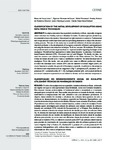Use este identificador para citar ou linkar para este item:
http://www.alice.cnptia.embrapa.br/alice/handle/doc/1072262Registro completo de metadados
| Campo DC | Valor | Idioma |
|---|---|---|
| dc.contributor.author | LIMA, E. de S. | pt_BR |
| dc.contributor.author | SOUZA, Z. M. de | pt_BR |
| dc.contributor.author | OLIVEIRA, S. R. de M. | pt_BR |
| dc.contributor.author | LOVERA, L. H. | pt_BR |
| dc.contributor.author | FARHATE, C. V. V. | pt_BR |
| dc.date.accessioned | 2017-07-07T11:11:11Z | pt_BR |
| dc.date.available | 2017-07-07T11:11:11Z | pt_BR |
| dc.date.created | 2017-07-07 | pt_BR |
| dc.date.issued | 2017 | pt_BR |
| dc.identifier.citation | Cerne, v. 23, n. 2, p. 201-208, 2017. | pt_BR |
| dc.identifier.uri | http://www.alice.cnptia.embrapa.br/alice/handle/doc/1072262 | pt_BR |
| dc.description | Abstract - Eucalyptus plantation has expanded considerably in Brazil, especially in regions where soils have low fertility, such as in Brazilian Cerrados. To achieve greater productivity, it is essential to know the needs of the soil and the right moment to correct it. Mathematical and computational models have been used as a promising alternative to help in this decisionmaking process. The aim of this study was to model the influence of climate and physicochemical attributes in the development of Eucalyptus urograndis in Entisol quartzipsamment soil using the decision tree induction technique. To do so, we used 30 attributes, 29 of them are predictive and one is the target-attribute or response variable regarding the height of the eucalyptus. We defined four approaches to select these features: no selection, Correlationbased Feature Selection (CFS), Chi-square test (?2) and Wrapper. To classify the data, we used the decision tree induction technique available in the Weka software 3.6. This data mining technique allowed us to create a classification model for the initial development of eucalyptus. From this model, one can predict new cases in different production classes, in which the individual wood volume (IWV) and the diameter at breast height (DBH) are crucial features to predict the growth of Eucalyptus urograndis, in addition to the presence of chemical soil components such as: magnesium (Mg+2), phosphorus (P), aluminum (Al+3), potassium (K+), potential acidity (H + Al), hydrogen potential (pH), and physical attributes such as soil resistance to penetration and related to climate, such as minimum temperature. | pt_BR |
| dc.language.iso | eng | eng |
| dc.rights | openAccess | eng |
| dc.subject | Mineração de dados | pt_BR |
| dc.title | Classification of the initial development of eucaliptus using data mining techniques. | pt_BR |
| dc.type | Artigo de periódico | pt_BR |
| dc.date.updated | 2018-02-28T11:11:11Z | pt_BR |
| dc.subject.thesagro | Eucalipto | pt_BR |
| dc.subject.nalthesaurus | Eucalyptus | pt_BR |
| dc.subject.nalthesaurus | Technology | pt_BR |
| riaa.ainfo.id | 1072262 | pt_BR |
| riaa.ainfo.lastupdate | 2018-02-28 -03:00:00 | pt_BR |
| dc.identifier.doi | 10.1590/01047760201723022296 | pt_BR |
| dc.contributor.institution | ELIZEU DE SOUZA LIMA, Unicamp; ZIGOMAR MENEZES DE SOUZA, USP, Jaboticabal; STANLEY ROBSON DE MEDEIROS OLIVEIRA, CNPTIA; LENON HENRIQUE LOVERA, Unicamp; CAMILA VIANA VIEIRA FARHATE, Unicamp. | pt_BR |
| Aparece nas coleções: | Artigo em periódico indexado (CNPTIA)  | |
Arquivos associados a este item:
| Arquivo | Descrição | Tamanho | Formato | |
|---|---|---|---|---|
| classificacaodesenv.pdf | 717,21 kB | Adobe PDF |  Visualizar/Abrir |









